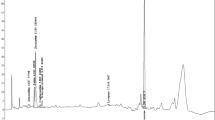Abstract
This study investigated the nutritional effect of sunflower seed proteinfraction (SSPF) extracted with isopropanol on growth, plasma and tissuelipid profile, protein content and erythrocyte membrane lipid profile ofrats. Dehulled sunflower seeds were extracted with isopropanol at 50±1 °C resulting in a protein fraction (71.5%) with low residualchlorogenic acid (0.07%) and fiber (3.3%) contents. Rats fed thesunflower seed protein fraction had a similar body weight gain and foodefficiency ratios in comparison to those fed casein. Rats fed SSPF incontrast had a significantly higher growth and food efficiency ratio thanthe rats fed sunflower meal (SM), extracted with hexane. However,dietary proteins exerted a separate effect on plasma total cholesterol,low density lipoprotein (LDL)-cholesterol, low density lipoprotein to highdensity lipoprotein cholesterol (LDL-C/HDL-C) ratio and triglyceridecontent. Sunflower seed protein fraction resulted in a significantdecrease in plasma cholesterol (p < 0.05) and LDL-cholesterol (p <0.02) levels compared to the casein fed rats. Membrane phospholipidprofile also showed a marked variation with the type of dietary protein.Rats fed SSPF and SM did not show much variation in plasma lipids, plasmaproteins, liver and brain lipids and membrane phospholipid concentrations.Protein content, liver and brain lipid profile of the groups fed SSPF andcasein were comparable, suggesting that the nutritional value of SSPF isbetter than SM and equivalent to that of casein.
Similar content being viewed by others
References
Chandinin DR (1958) Processing plant protein foodstuff. New York, NY: Academic Press, p 557.
Pierpoint W (1969) o-Quinones formed in plant extracts: Their reactions with amino acids and peptides. J Biochem 112: 609–616.
Liebowitz Z, Ruckenstein C (1985) Processing and utilization of sunflower meals and residues. In: World Conference on Emerging Technologies in the Fats and Oil Industry, pp 208–212.
Sastry Shamanthaka MC, Rao Narasinga MS (1991) Effect of chemical modification of sunflower 11 S protein on the binding of chlorogenic acid. J Agric Food Chem 39: 63–66.
Pomenta JV, Burns EE (1971) Factors affecting chlorogenic, quinic and caffeic acid levels in sunflower kernels. J Food Sci 36: 190–259.
Venktesh A, Prakash V (1993) Low molecular weight proteins from sunflower (Helianthus annuus L) seed: Effect of acidic butanol treatment on the physicochemical properties. J Agric Food Chem 41: 193–196.
Venktesh A, Prakash V (1993) Functional properties of the total proteins of sunflower (Helianthus annuus L) seed – effect of physical and chemical treatments. J Agric Food Chem 41: 18–23.
AOCS (1971) Official and Tentative Method, Vol. 1. Method Bc 2–49, Bc 5–49, Bc 3–49, Bc 6–49, Ba 10–65, Ba 11–65.
Pharmacopia of India (1985) Published by the Controller of Publications, Delhi, Vol. 11, Method C of A–65.
Debois M, Gilles KA, Hamilton JK, Rebers PA, Smith F (1956) Colorimetric method of determination of sugars and related substances. Anal Chem 28: 350.
Alaiz M, Navarro JL, Giron J, Vioque E (1992) Amino acid analysis by high performance liquid chromatography after derivatisation with diethyl ethoxymethylenemalonate. J Chromatog 591: 181–186.
Ray S, Bhattacharyya DK (1995) Comparative nutrition study of enzymatically and chemically interesterified plam oil products. J Am Oil Chem Soc 72: 327–330.
Kates M(1972) Techniques of Lipidology. New York: American Elsevier Publishing Co, Inc, pp 349–351.
Allian CC, Lucy SP, Chan CSG, Richmond W, Fu PC (1974) Enzymatic determination of total serum cholesterol. Clin Chem 20: 470–475.
Warnick GR, Nguyen T, Albers A (1985) Comparison of improved methods for quantification of high density lipoproteins. Clin Chem 31: 217–222.
Friedewald WT, Levy RI, Fredrickson DS (1972) Estimation of the concentration of low density lipoprotein in plasma without use of the preparative ultracentrifuge. Clin Chem 18: 499–502.
Hatch FT, Lees RS (1968) Practical methods for plasma lp. analysis. Adv Lipid Res 6: 1–3.
Bucolo G, David M (1973) Quantitative determination of serum triglyceride by the use of enzymes. Clin Chem 19: 476–482.
Chen PS, Toribara TY, Warner H (1956) Micro determination of phosphorus. Anal Chem 28: 1756–1758.
Doumas BT (1981) A candidate reference method of determination of total protein in serum, 1: Development and validation. Clin Chem 27: 1642–1650.
Doumas BT, Watson W (1971) Albumin standard and the measurement of serum albumin with bromocresol green. Clin Chem Acta 31: 87–96.
Rose HG, Oklander M (1965) Improved procedure for the extraction of lipids from human erythrocytes. J Lipid Res 6: 428–431.
Sugiyama K, Yamakawa A, Kumazawa A, Saeki S (1997) Methionine content of dietary proteins affects the molecular species composition of plasma phosphatidylcholine in rats fed a cholesterol free diet. J Nutr 127: 600–607.
Pearson ES, Hartley HO (1996) Biometrika Tables for Statisticians, Vol. 1. Cambridge: Hartley, Table 2.
Kritchevsky D (1979) Vegetable protein and atherosclerosis. J Am Oil Chem Soc 56: 135–140.
Rajamohan T, Kurup PA (1997) Lysine: arginine ratio of a protein influence cholesterol metabolism: Part 1 – studies on sesame protein having low lysine: arginine ratio. Ind J Exp Biol 35: 1218–1223.
Author information
Authors and Affiliations
Rights and permissions
About this article
Cite this article
Sen, M., Bhattacharyya, D. Nutritional quality of sunflower seed protein fraction extracted with isopropanol. Plant Foods Hum Nutr 55, 265–278 (2000). https://doi.org/10.1023/A:1008152201872
Issue Date:
DOI: https://doi.org/10.1023/A:1008152201872




